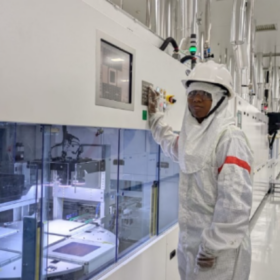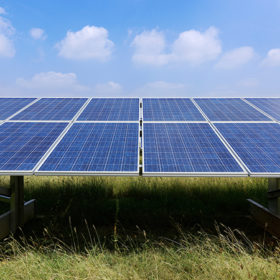Top News
India achieves 50% clean power capacity five years ahead of target

Alpex Solar secures 300 MW PV cell deal with TP Solar

Meeting evening peaks with clean power requires a three-pronged strategy: IEEFA
Out now - pv magazine Global June edition
pv magazine Webinar

Upcycling solar glass waste to use in solid-state lithium batteries

Saudi Arabia signs 5 solar PPAs totaling 12 GW
SAEL to set up 5 GW solar cell and module manufacturing facility in Uttar Pradesh
Four-year outdoor testing shows perovskite cells suffer from high seasonality
Huawei leads global inverter market as shipments hit 589 GW in 2024
Markets & Policy
Featured
Shakti Pumps invests INR 12 crore in solar manufacturing arm
Adani Green Energy allots 1.09 crore equity shares to Ardour upon warrant conversion
The promoter group’s shareholding in Adani Green Energy Ltd (AGEL) has now increased from 61.91% to 62.17%.
“Energy storage will account for half our business within three years”: Geon vice president
Khushi Kabra, Vice President–Strategy at Geon (formerly Battrixx), speaks to pv magazine on pivoting from electric vehicle (EV) batteries to building a strong foothold in the energy storage space.
What standards for agrivoltaics?
The technology which combines solar PV panels and agriculture is gaining ground. IEC Standards for solar photovoltaic (PV) systems already exist, but more might be required, dealing with some of the more specific issues relating to agriculture.
How is India’s power infrastructure evolving amid global supply chain shifts?
With renewable capacity expanding, grid upgrades underway, and policies fostering local supply chains, India is navigating a complex but promising energy transition.
The Hydrogen Stream: IIT Madras, Hyundai to launch green hydrogen innovation centre
Hyundai Motor India Ltd (HMIL), in collaboration with IIT Madras, will establish a 65,000 sq. ft. green hydrogen innovation centre in Chennai, enabling research, development, and deployment of hydrogen technologies.
Installations
Featured
How homeowners in Tier 2 cities are switching to solar
GP Eco Solutions secures EPC contract for 31.67 MW C&I solar project in Punjab
GP Eco Solutions has secured an INR 121.92 crore EPC (engineering, procurement, and construction) contract for a ground-mounted, grid-connected solar power project with a capacity of 24 MW AC (31.67 MW DC).
Brazil may add 36.5 GW of solar by 2029, says grid operator
Brazil’s installed solar capacity is expected to rise from 51.7 GW in December 2024 to 88.2 GW by the end of 2029, according to the national grid operator’s 2025–29 Energy Operation Plan.
Adani Green Energy Ltd achieves 15.8 GW of operational renewable energy capacity
Adani Green Energy Ltd’s cumulative operational renewable energy capacity reached 15.8 GW as of June 30, 2025, 45% up from 10.9 MW as of June 30, 2024.
India installed record 21.9 GW of solar and wind capacity in H1 2025: JMK Research
The nation added 18.3 GW of solar capacity and around 3.5 GW of wind capacity during the Jan.–June period of 2025, according to JMK Research.
Italy’s latest renewables auction attracts 17.5 GW of solar project proposals
Italy’s first solar auction under the transitional FER X incentive scheme drew 17.5 GW in project proposals and an additional 2.87 GW in wind bids, according to state-run energy agency Gestore dei Servizi Energetici (GSE).
Technology
Featured
“India on track to achieve 50% renewable energy milestone by year-end”: Union power minister
Photovoltaics for atmospheric water harvesting
A scientist in Turkey has simulated eight PV-supported hybrid atmospheric water harvesting systems and compared their performances. They were all considered to operate with R1233zd(E), R1234yf, and R600a, as well as R32 refrigerants. The required PV system size was as low as 20 m2.
Honeywell adds Li-ion Tamer for battery fire safety in buildings
Honeywell has acquired the Li-ion Tamer business from Nexceris, a leader in off-gas detection technology for lithium-ion batteries. Li-ion Tamer’s early warning technology detects battery off-gassing, which typically precedes thermal runaway, providing facilities with vital time to intervene before a battery fire starts.
AM Green acquires stake in Greenko from ORIX
The stake acquisition enhances AM Green’s upstream integration with Greenko, which runs over 10 GW of renewable and pumped storage assets and is building the world’s largest “Intelligent Energy Storage Cloud Platform.”
Solarium, NISE sign MoU to develop solar-based heating solutions for cold regions
Solarium Green Energy Ltd has signed a Memorandum of Understanding (MoU) with the National Institute of Solar Energy (NISE), under the Ministry of New and Renewable Energy, to jointly develop advanced solar-based heating technologies.
John Cockerill Hydrogen raises €116 million to drive global growth
The amount covers nearly all the funding required to accelerate the development of John Cockerill’s hydrogen business, including the rollout of next-generation pressurized alkaline electrolyzer technologies and international expansion.
Manufacturing
Featured
Ola Electric targets full 5 GWh battery cell capacity by the end of FY2026
China polysilicon price increases amid regulatory signals
In a new weekly update for pv magazine, OPIS, a Dow Jones company, provides a quick look at the main price trends in the global PV industry.
NREL, CubicPV achieves 24% efficiency for perovskite mini solar module
A U.S.-based collaboration between the National Renewable Energy Laboratory (NREL) and CubicPV has yielded a perovskite minimodule with certified efficiency of 24.0%. The two noted that it is the first time a U.S. effort has set a record in the perovskite mini module category.
India’s emerging role in EV battery recycling: Creating a circular economy
India is well-placed to advance the e-mobility circular economy in Asia against the backdrop of the fast-growing market and recycling strategies. Adopting the 5Rs—Reduce, Reuse, Repurpose, Remanufacture, and Recycle—can help in reducing resource depletion and waste.
Longi unveils 34.58%-efficient tandem perovskite-silicon solar cell based on asymmetric self-assembled monolayer
In a new scientific paper published in nature, the Chinese manufacturer presented a new tandem perovskite-silicon solar cell based on a bottom cell with a heterojunction design. It also used a new type of self-assembled monolayer that reportedly reduces non-radiative recombination and increases cell efficiency.
Australian Clean Energy delegation visits India to further deepen their engagements
A 30-member Australian Clean Energy Delegation representing 22 companies, is visiting India from July 7 – 11, 2025 to showcase Australia’s innovative solutions across energy storage technologies, AI solutions for energy operations, solar technologies, green hydrogen, energy modelling and weather forecasting, education & capacity building and consulting.
Energy Storage
Featured
Australia’s green hydrogen plan faces water shortage
Tata Power inaugurates green energy skilling centre in Delhi
Tata Power’s Green Energy Skill Centre will impart training in renewable energy technologies, including solar PV system installation, commissioning and operation and maintenance, energy storage, pumped hydro storage, and electrical safety to prepare future-ready green energy workforce for the country’s energy transition.
Oriana Power secures BESPA for 50 MW/ 100 MWh battery energy storage systems in Rajasthan
Oriana Power has signed a 12-year battery energy storage purchase agreement (BESPA) with Rajasthan Rajya Vidyut Utpadan Nigam Ltd for 50 MW/100 MWh of standalone battery energy storage systems in Rajasthan.
Powering a greener future through India’s clean energy transition
As India adds more intermittent renewables like solar and wind to its energy mix, modernising the electricity grid becomes a priority. Grid expansion, integration of battery storage systems, and digital monitoring tools are critical to accommodate fluctuations in generation and demand.
NLC India to infuse INR 1,631 crore into renewable energy arm
State-owned NLC India Ltd has approved an investment of up to INR 1,630.89 crore in its wholly owned subsidiary, NLC India Renewables Ltd (NIRL), through equity infusion
WoodMac: World needs 1.4 TW of grid-forming batteries by 2034
The data company says investments of $1.2 trillion in battery energy storage systems (BESS) will be required to support the installation of over 5.9 TW of new wind and solar capacity globally through 2034.
Opinion & Analysis
Featured
Bringing back-contact to the foreground
US solar panel price from India stable at $0.288/W
In a new weekly update for pv magazine, OPIS, a Dow Jones company, provides a quick look at the main price trends in the global PV industry.
India’s next solar frontier: Captive projects are powering industrial self-reliance
Industrial belts in Punjab, Haryana, Maharashtra, Gujarat, and Tamil Nadu are becoming hotspots for captive solar. The drivers vary from steep tariffs and policy incentives to strong ESG commitments by export-oriented businesses, but the result is the same: a distributed solar network powering India’s industrial economy.
The impact of module pricing on solar project viability: Trends and predictions
India’s solar sector faces rising module costs due to recent developments, including the imposition of anti-dumping duties on solar glass and China’s reduction in export rebates on solar modules, impacting project viability. These shifts underline the delicate balance between promoting local manufacturing, pursuing geopolitical strategies, and navigating the economic realities of global trade.
Why solar power can’t just be industries’ CSR afterthought
Companies that treat solar as a core part of their energy strategy, rather than a side initiative, often see these benefits play out with striking clarity. The investment case is strong. In most cases, payback happens within five to seven years. After that, solar becomes a net-positive contributor to the balance sheet.
Wafer producers scramble to stay afloat despite hydropower advantage
In a new weekly update for pv magazine, OPIS, a Dow Jones company, reports that FOB China wafer prices remained stable this week amid weak demand and low production. It says manufacturers continue to face margin pressure despite seasonal hydropower cost relief and traceability documentation premiums.




